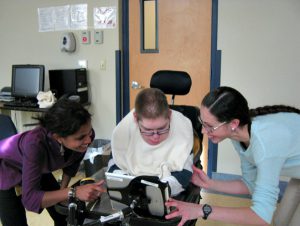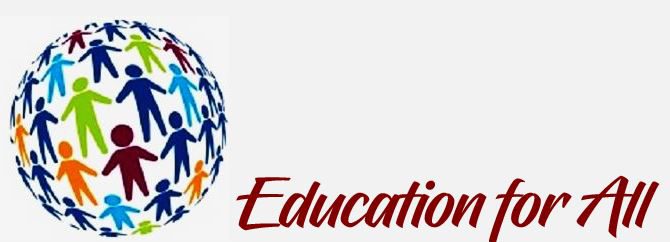Contact:
Robert McKinney, Lead Speech-Language Pathologist
(619) 796-7512
Robert.Mckinney@sweetwaterschools.org
Speech-Language Pathologists (SLPs) in the schools work with children who have communication problems that affect their education. California Ed code outlines four categories of speech and language disorders:
- Articulation – when a student’s speech has a significant impact on education.
- Voice – when a student has persistent, defective voice quality, pitch, or loudness.
- Fluency – generally when a student’s stuttering adversely affects communication.

- Language Disorder – typically when a student’s language skills are below the 7th percentile when compared to peers.
Location of the service: Services are generally provided at students’ schools.
FAQs
What is an SLP?
SLP is the abbreviation for a Speech-Language Pathologist, often known as a speech therapist or speech pathologist. There are many terms in use for this profession, and SLPs often use different terms themselves depending upon the situation. The word “language” was added to the title in the 1980s to reflect a shift in the role of SLPs since they work on disabilities involving both oral language and language use in general. SLP will be used in these FAQs as a generic term for the district specialist assigned by Special Services to provide speech/language services listed in a student’s Individual Education Plan (IEP).
Who is the SLP at my site?
SLPs in the Sweetwater district are part of Special Services and they are assigned to cover different sites. Some sites have one SLP serving all of the students while others have two or more SLPs. In some cases an SLP with expertise in a particular area (i.e. autism, cultural/linguistic diversity) may assist the SLP at your site with evaluation or treatment. You should be able to find your site’s SLP easily, but you can also check with your school administration.
How do I refer a student for Speech/Language services?
The Individuals with Disabilities Education Act (IDEA) mandates that students receive their education in the least restrictive environment, therefore it is important that all support options in general education are exhausted before special education services are considered. Often a referral will be made through the SST process, at an IEP meeting, or by a parental request in writing. When an SLP agrees to evaluate a student, then an assessment plan is signed and the process begins. If a student is determined to be eligible for speech/language services, an IEP will be created, or the services will be added to an existing IEP.
What does the assessment process entail?
The SLP will use formal and/or informal measures to determine whether the student has a speech/language disorder falling under one of the following categories: articulation, voice, fluency, or language disorder. The student’s communication difficulties must have a significant impact on education.
How do SLPs serve the students on their caseloads?
The IEP team establishes the type of service delivery, and it can take many forms. IDEA mandates that students receive their education in the least restrictive environment, but in some cases the SLP may take the student out of class for individual work if it is considered appropriate. In other cases, students are pulled from class to work in small groups. It is becoming more common to provide services in the classroom using a variety of collaborative approaches.
Do teachers have to release students for speech/language services? Do they have to allow SLPs to work in the classroom with students?
The intent of IDEA and special education is that students, teachers, special educators, and families work together as a team to provide optimal conditions for a free and appropriate public education. If a student has an IEP with speech/language services then those services are mandated by law and the district is obligated to provide them. In an ideal world, all members of the IEP team, including the student’s teachers should collaborate to determine the best way to deliver services, and the teacher’s opinion should carry a great deal of weight. In most cases, discussing services with the SLP and reviewing available options should help resolve questions of timing and delivery.
What kind of training do SLPs have?
SLPs have completed both the required undergraduate coursework and a Master’s Degree program in communicative disorders. SLPs often add the letters “CCC-SLP” to indicate that they have attained a certificate in clinical competency from the American Association of Speech-Language Pathologists. To obtain this certificate, SLPs must pass a national examination and complete a supervised internship year. All SLPs working in the district must have a credential, and some may also be licensed by the state.
How does speech therapy benefit students?
This depends a great deal on the type and severity of the disorder, the age of the student, student motivation, therapy methods, as well as many other factors. Despite this variance, as a rule, studies show that speech/language therapy provides a benefit. In some cases, articulation disorders are remediated and the student is released from special education. In other cases, students may learn to manage their disorder and their education is enhanced greatly.
Do SLPs work with students in general education?
At times, SLPs may be involved in providing consultation or collaboration to address speech/language concerns for general education students as a part of the Response to Intervention (RtI) model. SLPs often address questions and concerns from teachers about students in their classes.
Are there any students who are not in special ed classes who receive speech/language services?
Yes, some students are in IEPS with only speech/language services. These students are sometimes called “speech only” or “unduplicated students. Although they have the same legal rights as any other student in special education, they usually attend general education exclusively with the exception of the times they are working with the SLP. The SLP is the case carrier for these students.
Do SLPs work with English Learners (ELs)?
Yes and no. SLPs work with ELs who have a language disability, but they do not work with students just because they are ELs.It is important to distinguish between language differences and disabilities. There are obviously many English learners in the district, and some of them have speech/language disabilities, so it is appropriate for SLPs to work with them. On the other hand, if a student’s only language difficulties are related to learning English as a second language, then the student does not have a true disability, and needs would best be met by the ELD department and general education teachers. Unfortunately, it can be difficult to make the determination between difference and disability. The best way to determine this is to assess the student’s abilities in the strongest language, but this is not always practical.
What is a language disorder?
As outlined above, students are eligible for speech/language services under the categories of: articulation, voice, fluency, and language disorder. The first three categories refer to how students sound, and SLPs refer to them as speech disorders. Language disorders are divided into the following subcategories: morphology, syntax, semantics, or pragmatics. Morphology refers to word endings, such as the past tense, syntax is another word for the grammatical rules of a language that are not based on stylistic considerations, semantics involves vocabulary and meaning, and pragmatics refers to a problem with social language.
What are some good strategies that can help students who have a language disorder?
Students who have a mild language disorder at an early age are often able to catch up their peers, but many older students will have to manage their difficulties with language for the rest of their lives. Our educational system is heavily language based, so students with language delays tend to face ever growing deficits as they advance through school. Speech therapists often focus on developing strategies that students can use in the classroom and life depending on their area of need. Teachers and parents can be cognizant of how they use language themselves, so that students with deficits are given linguistic information in smaller chunks, with more repetition, and with reinforcement through other modalities. Teachers and parents can highlight features of language in order to foster the development of metalinguistic skills. Strategies related to vocabulary development such as inferring from context and analyzing affixes and roots can also be effective. Finally, students need to develop self-advocacy skills such as asking questions, and collaborating with others.
Why do people stutter?
Stuttering has primarily a genetic cause, although its development can be affected by the environment and an individual’s reaction to it. People who stutter are overwhelmingly male (80%) and they make up about 1% of the population. As many as 5% of children go through a stuttering phase, but in most cases this passes. There is no cure for stuttering, so therapy focuses on treatment and management.
How can I help a student who stutters?
Stuttering is not related to intelligence, but many listeners mistakenly assume it is. Many students who stutter are unaware of the genetic cause of the disorder, so they feel ashamed to speak in class or in social situations. They often face mockery and discrimination. Work with students who stutter to create a safe environment for them to participate in class. In some cases this may involve adapting oral assignments or adjusting participation grades. People who stutter are capable of getting their message out even if it takes some extra time, so being a patient listener is one of the best things you can do.
Should a student with a lisp get speech therapy?
A middle-school or high-school student with a lisp whose speech is highly intelligible would in most cases not be considered to have a disability. The trend has been to work with these students outside of the IEP system using the RtI model if necessary. Some important additional considerations would be the student’s self-esteem and willingness to participate in oral activities.
Where are the best places to go for more information?
The American Speech-Language Hearing Association website (www.asha.org) linked below is an excellent resource for any questions related to the field.
How do I become an SLP?
Speech-language pathologists tend to be people who love language and enjoy working closely with people with disabilities. SLPs typically work in schools, hospitals, private clinics, or at universities. The career can be very rewarding and job satisfaction and prospects for future growth are generally strong. A shortage of training programs means that competition for graduate slots can be very discouraging, but anyone with a passion for the field should follow their dream. Teaching and special education backgrounds are very helpful as are any abilities in another language. A good starting place would be the ASHA website (www.asha.org) or a chat with an SLP.
